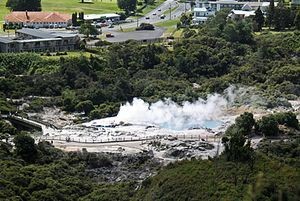 Geothermal vegetation at Whakarewarewa, Rotorua. Photo: Chris Bycroft.Geothermal vegetation is highly variable, reflecting influences of factors such as soil temperature, the presence of permanent water and ephemeral wetlands, acidity and other chemical aspects of soil and water, altitude, and the age of the geothermal activity at a particular site.
Geothermal vegetation at Whakarewarewa, Rotorua. Photo: Chris Bycroft.Geothermal vegetation is highly variable, reflecting influences of factors such as soil temperature, the presence of permanent water and ephemeral wetlands, acidity and other chemical aspects of soil and water, altitude, and the age of the geothermal activity at a particular site.
There is considerable interest in how soil chemistry and temperature (environmental gradients) has influenced the vegetation at geothermal sites (c.f. Given 1995 and Burns and Leathwick 1995).
Vegetation assemblages at geothermal sites iinclude lichenfield, mossfield, herbfield, fernland, scrub, shrubland, rushland, sedgeland, reedland, forest, wetland and open water habitats, and geothermally-influenced bare ground. They also occur over a wide range of altitudes, from sea level to the summits of the Central North Island Volcanoes and Mt Tarawera.
For more information see*
- Geothermal vegetation dynamics by Bruce Burns and John Leathwick (1995). Part 1: Map of Geothermal Vegetation of the Te Kopia Scenic Reserve. Part 2: Plant species organisation along major environmental gradients. Science for Conservation 18. Department of Conservation, Wellington. 26pp
- Given D.R. 1995: Geothermal Vegetation - an assessment of botanical values of selected geothermal sites in the Taupo Volcanic Zone. David Given and Associates, Christchurch.
*The Network is not responsible for the content of external internet sites
